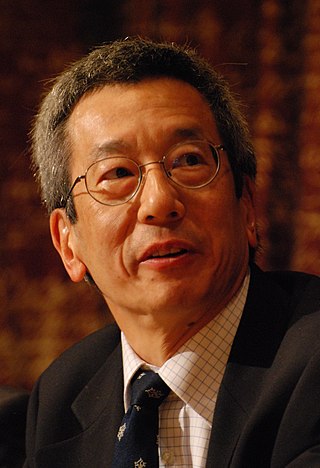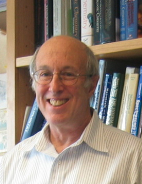Related Research Articles

Britton "Brit" Chance was an American biochemist, biophysicist, scholar, and inventor whose work helped develop spectroscopy as a way to diagnose medical problems. He was "a world leader in transforming theoretical science into useful biomedical and clinical applications" and is considered "the founder of the biomedical photonics." He received the National Medal of Science in 1974.

Matthias Mann is a German physicist and biochemist. He is doing research in the area of mass spectrometry and proteomics.

John Kuriyan is the dean of basic sciences and a professor of biochemistry at Vanderbilt University School of Medicine. He was formerly the Chancellor's Professor at the University of California, Berkeley in the departments of molecular and cell biology (MCB) and chemistry, a faculty scientist in Berkeley Lab's physical biosciences division, and a Howard Hughes Medical Institute investigator. He is a member of the National Academy of Sciences and he has also been on the Life Sciences jury for the Infosys Prize in 2009, 2019 and 2020.
Alan G. Marshall is an American analytical chemist who has devoted his scientific career to developing a scientific technique known as Fourier transform ion cyclotron resonance (FT-ICR) mass spectrometry, which he co-invented.

Roger Yonchien Tsien was an American biochemist. He was a professor of chemistry and biochemistry at the University of California, San Diego and was awarded the Nobel Prize in Chemistry in 2008 for his discovery and development of the green fluorescent protein, in collaboration with organic chemist Osamu Shimomura and neurobiologist Martin Chalfie. Tsien was also a pioneer of calcium imaging.

Otto Knut Olof Folin was a Swedish-born American chemist who is best known for his groundbreaking work at Harvard University on practical micromethods for the determination of the constituents of protein-free blood filtrates and the discovery of creatine phosphate in muscles.

The American Society for Biochemistry and Molecular Biology (ASBMB) is a learned society that was founded on December 26, 1906, at a meeting organized by John Jacob Abel. The roots of the society were in the American Physiological Society, which had been formed some 20 years earlier. ASBMB is the US member of the International Union of Biochemistry and Molecular Biology.
The Royal Netherlands Chemical Society is a learned society and professional association founded in 1903 to represent the interests of chemists and chemical engineers in the Netherlands. Currently the organisation has approximately 7,400 members.

Dame Carol Vivien Robinson, is a British chemist and former president of the Royal Society of Chemistry (2018–2020). She was a Royal Society Research Professor and is the Dr Lee's Professor of Physical and Theoretical Chemistry, and a professorial fellow at Exeter College, University of Oxford. She is the founding director of the Kavli Institute for Nanoscience Discovery, University of Oxford, and she was previously professor of mass spectrometry at the chemistry department of the University of Cambridge.

Biophysical chemistry is a physical science that uses the concepts of physics and physical chemistry for the study of biological systems. The most common feature of the research in this subject is to seek an explanation of the various phenomena in biological systems in terms of either the molecules that make up the system or the supra-molecular structure of these systems. Apart from the biological applications, recent research showed progress in the medical field as well.
The Chemical Society of Japan (CSJ) is a learned society and professional association founded in 1878 in order to advance research in chemistry. The mission of the CSJ is to promote chemistry for science and industry in collaboration with other domestic and global societies.

Henry M. Fales was an American organic chemist and mass spectrometrist. He authored and co-authored over 350 scientific publications on natural substances and biochemistry.
The following outline is provided as an overview of and topical guide to biophysics:

David E. Cane is an American biological chemist. He is Vernon K. Krieble Professor of Chemistry Emeritus and professor of molecular biology, cell biology, and biochemistry emeritus at Brown University in Providence, Rhode Island. He is recognized for his work on the biosynthesis of natural products, particularly terpenoids and polyketides. He was elected as a Fellow of the American Association for the Advancement of Science in 2003 and as a Fellow of the American Academy of Arts and Sciences in 2013.

The Chinese Chemical Society is a professional society of chemists headquartered in Beijing. It is part of the China Association for Science and Technology. Current membership is at around 55,000.
Marjorie Janice Groothuis Horning was an American biochemist and pharmacologist. She was considered to be a pioneer of chromatography for her work in developing new techniques and applying them to the study of drug metabolism. She demonstrated that drugs and their metabolites can be transferred from a pregnant woman to her developing child, and later through breast milk, from a mother to a baby. Horning's work made possible the prevention of birth defects, as doctors began to warn of the dangers of drugs, alcohol, and smoking during pregnancy.
References
- ↑ "Welcome to NetSci's List of Professional Societies for Chemistry". Network Science Corporation. Retrieved 2009-08-05.